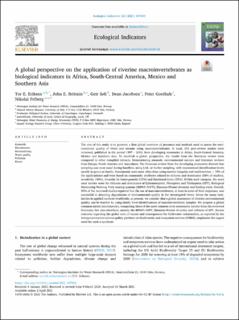| dc.description.abstract | The aim of this study is to generate a first global overview of pressures and methods used to assess the environmental quality of rivers and streams using macroinvertebrates. In total, 314 peer-review studies were reviewed, published in the period 1997 – 2018, from developing economies in Africa, South-Central America, Mexico and Southern Asia. To establish a global perspective, the results from the literature review were compared to other compiled datasets, biomonitoring manuals, environmental surveys and literature reviews from Europe, North America and Australasia. The literature review from the developing economies showed that sampling was most usual during baseflow, using kick- or Surber sampling, with taxonomical identification levels mostly to genus or family. Assessments were most often done using metrics (singular and multimetrics; > 70% of the applications) and were based on community attributes related to richness and dominance (58% of studies), sensitivity (40%), diversity by heterogeneity (32%) and functional traits (25%). Within each category, the most used metrics were the richness and dominance of Ephemeroptera, Plecoptera and Trichoptera (EPT), Biological Monitoring Working Party scoring systems (BMWP/ASPT), Shannon-Wiener diversity and feeding traits. Overall, 92% of the reviewed studies reported that the use of macroinvertebrates, at least in some of their responses, was successful in detecting degradation of environmental quality in the investigated rivers. Given the many similarities in applied methods worldwide, at present, we consider that a global assessment of riverine environmental quality can be feasible by using family level identifications of macroinvertebrate samples. We propose a global common metric (multimetric), comprising three of the most common river assessment metrics from the reviewed literature, but also elsewhere, namely the BMWP/ASPT, Shannon-Wiener diversity and richness of EPT. Recent concerns regarding the global state of nature and consequences for freshwater communities, as reported by the intergovernmental science-policy platform on biodiversity and ecosystem services (IPBES), emphasize the urgent need for such a synthesis. | |

